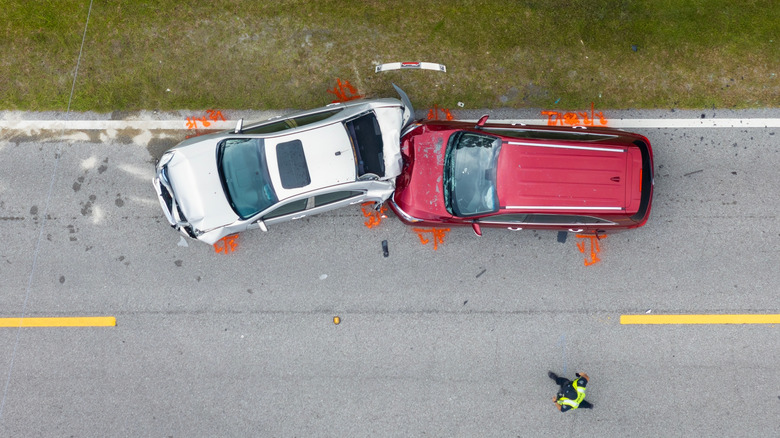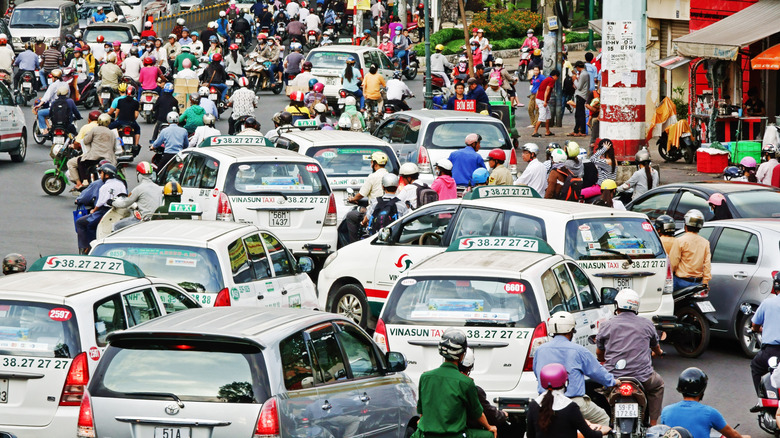The Most Dangerous Thing You Can Do In Any Country Is A Very Common Tourist Activity
Travel is risky. That's part of what we like about it; we leave our comfort zones and enter unfamiliar spaces. We cast aside familiar customs and language in an effort to test ourselves, push our boundaries, and enrich our understanding of the world. This is a noble goal, and when it all works out, we walk away with a feeling of accomplishment, plus a slew of new friends. We may even embrace serious challenges and learn how to act fast when missing a connecting flight due to a delay or losing a passport while traveling. Travel is largely about problem-solving, we remind ourselves, and whatever doesn't kill us makes us stronger.
But let's remember that some travelers do, in fact, die on vacation. These events are statistically rare; if you're smart and prepared, the chances of dying overseas are very low. That said, one of the government's grimmest public databases is the U.S. Citizen Deaths Overseas, which is maintained by the Department of State and catalogs every time a U.S. citizen expires on foreign soil, as well as the cause of death. Not all of these people were traveling for fun, but each case is tragic. Scrolling down the list, you'll see people whose lives were cut short by suicide, maritime accidents, and an astonishing number of drownings.
The deadliest activity is also the most normal: driving a car, listed here as "Veh. Accid-Auto." You'll see it over and over, with separate categories for motorcycles and pedestrians fatally struck. This is an especially important consideration if you're renting a car overseas, as the U.S. Department of State reportedly cites traffic accidents as the leading non-natural cause of death for citizens abroad. That pesky car rental could just be the most dangerous decision you make while traveling in another country.
To rent or not rent a car?
This is a difficult pill for Americans to swallow, as 92% of U.S. households have their own automobile, and the vast majority of U.S. citizens get around in private cars, even for the most local of errands. Millions of Americans balk at the idea of not driving, even on vacation. Truth be told, there are uncountable scenic road trips around the world; here are 50 roads you need to cruise before you... well, you know... spanning from Alaska to India to New Zealand. For many of these routes, part of the appeal is the rugged terrain and hint of danger.
Still, the fact remains: driving is always a dangerous activity, with more than 42,000 fatalities in 2022, just in the U.S. When traveling, you have to contend with a rental car, whose design and features may be completely unfamiliar to you. Most countries in the world use the metric system, so you'll have to adjust to kilometers for distance and speed limits. Depending on your destination, signage may appear only in native languages, often in alphabets that you can't even sound out, much less understand. While SIM cards and travel passes make GPS apps more accessible in other countries, you may run into all kinds of navigational problems, from outdated maps to patchy service. Then there are the roads themselves, where rough surfaces, unmarked lanes, weaving motorbikes, roaming livestock, and rampant overtaking are the norm.
How to survive a foreign roadway
Despite the dangers, many of us will still rent a car on vacation, even in places that intimidate us. There are plenty of countries that are hard to explore without a motor vehicle, as mass transit is slow or limited, and taxis and private shuttles can cost significantly more than simply driving ourselves. Switching on that ignition may dramatically increase our odds of injury or death, but hey, so does swimming in natural bodies of water, and we may very well do that, too.
For starters, make sure your rental is insured and your paperwork is in order. If a country requires an international driver's license, secure one from your local DMV or AAA before you depart. Read up on traffic laws (or look up video tutorials on YouTube), and try to acquaint yourself with standard signage. When you pull your car off the lot, take it slow; make sure to ease into the new environment as gradually as you can, practicing on low-traffic roads before you take on high-speed freeways and dense cities.
According to recent CDC data, certain countries are more dangerous than others for U.S. tourists. Compiling figures from 2016-2018 by the World Health Organization, the U.S. Department of State, and the U.S. Department of Commerce, the numbers show that Mexico had one of the worst track records: 126 American car-crash deaths, and an estimated 13.1 crash-related deaths per 100,000 people. This was perhaps understandable, given Mexico's proximity to the U.S. and the appeal of local tequila. But other nations also showed alarming numbers of collisions: 14 U.S. drivers died in the Philippines during the same time, 12 died in the Dominican Republic, and a gut-wrenching 29 in Thailand. While these data are older, of course, any road in the world can harbor danger. Your best bet? Skip the rental and let a local take the wheel.


